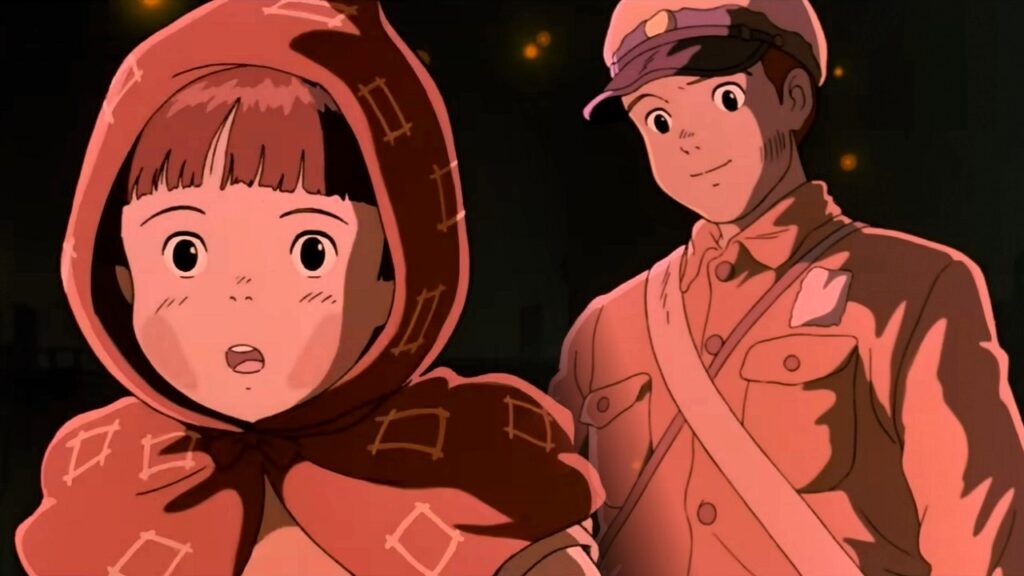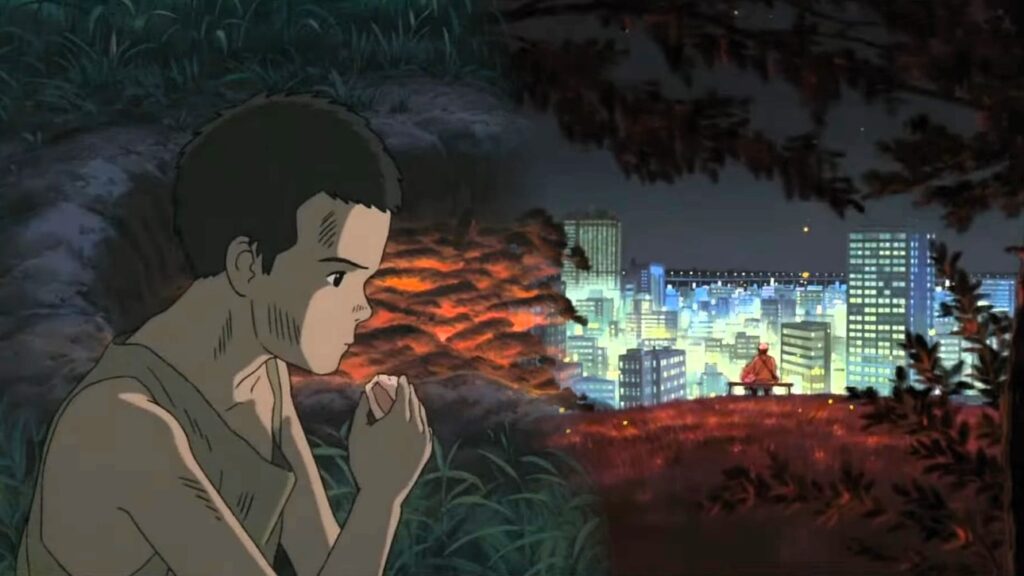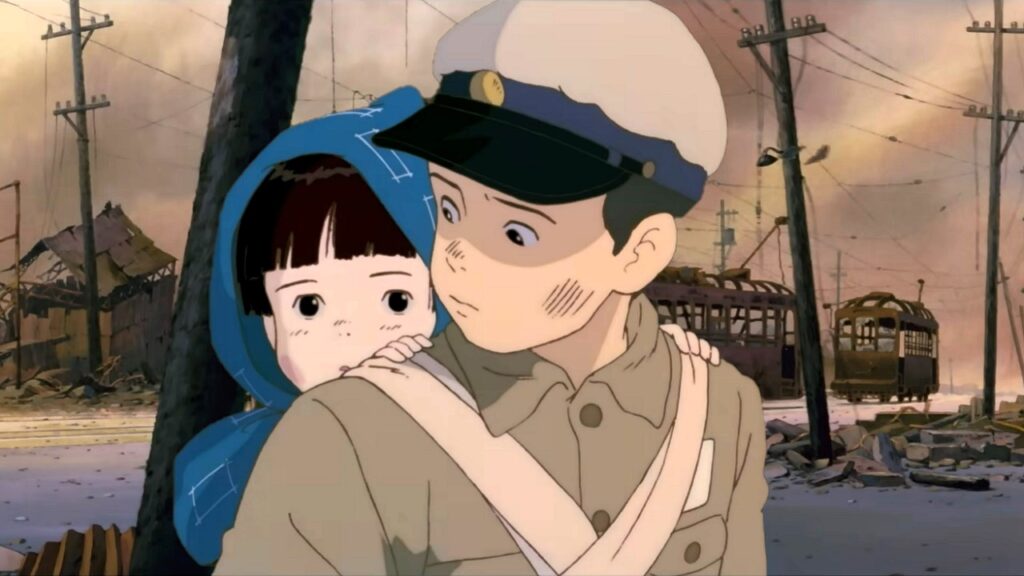Today’s post includes a brief plot summary, an analysis, a review, and an explanation about the ending of the film Grave of the Fireflies / Hotaru no Haka (1988). Beware of spoilers.
Directed by Isao Takahata, the 1988 Japanese anime drama is based on Akiyuki Nosaka’s novel of the same name. Today’s post is solely based on the film, not the novel.
Short Review: “Grave of the Fireflies” is a heart-breaking film, and it’s almost impossible to watch it without shedding a couple of tears. Nonetheless, the film is visually beautiful with a strong story that stands the test of time. Having said that, “Grave of the Fireflies” is definitely a noteworthy watch because it’s both a classic and a masterpiece.
“Grave of the Fireflies” opens with a sad scene: a teenage boy dies from starvation in a train station.
The protagonist of this story is Seita. After dying, his spirit reunites with Setsuko, his sister. Together they recount their tragic story.
During World War II, the siblings lost their house to the bombings that were gradually destroying their city. Although they manage to escape, their mother ends up dying from severe burns. Without any close relatives to take care of them, Seita and Setsuko end up living with a distant aunt.
However, as food becomes scarce, tensions rise between the siblings and their aunt. Seita decides to leave with Setsuko, believing he can care for her on his own. What follows is a merciless descent into hunger, illness, and despair.
Despite Seita’s best efforts, the harsh realities of war prove too much for the young children. In the end, Setsuko succumbs to malnutrition, leaving Seita alone and broken. The film concludes as it began, with Seita’s death, bringing their story full circle.
The film is based on true events, more specifically, the firebombing of Kobe, a devastating attack that occurred on March 16-17, 1945.
This wasn’t just any bombing—it was a massive operation involving 331 American B-29 bombers that unleashed hell on the city. The raid targeted key areas of Kobe, destroying three square miles (21% of the city) and killing nearly 9,000 residents.
What really hit me was how the film portrays the impact of these bombings on civilian life. It’s not just about the immediate destruction; it’s about the long-lasting effects on society.
We see how the war changes people, turning once-kind relatives into cruel, selfish individuals. The scarcity of food, the breakdown of social norms, and the constant fear of death create a world where our survival instincts bring out often the worst in all of us.
The fireflies in the film aren’t just pretty lights. These tiny, luminous insects represent the fleeting nature of life, especially in the context of war.
In hindsight, the presence of fireflies in “Grave of the Fireflies” is sort of a metaphor for Seita and Setsuko. As bright as fireflies can be, they don’t live for very long. For a very brief moment, we see Seita and Setsuko trying to make the best out of their current situation, and as viewers, we try to root for them, despite knowing how their story ends.
I found it particularly touching when Setsuko buries the dead fireflies, mirroring the burial of their mother. It’s a heartbreaking moment showing an innocent child trying to grasp the concept of death. The fireflies also symbolize hope—a light in the darkness that the children cling to. But just like the fireflies, that hope is fragile and short-lived.
Seita’s pride is a double-edged sword in this story.
On one hand, it drives him to protect and care for his sister at all costs. On the other, it leads to some disastrous decisions. His choice to leave their aunt’s house, while understandable given the tension, ultimately puts them in a far worse situation.
I found myself frustrated with Seita at times, wanting to shake some sense into him. But then I remembered—he’s just a kid, thrust into an impossible situation. His pride is intertwined with his sense of responsibility and his desire to live up to the image of his father, a naval officer.
The film doesn’t shy away from showing the consequences of Seita’s choices. It’s a harsh lesson in the reality that good intentions aren’t always enough, especially in times of war. The way the film balances sympathy for Seita’s situation with a clear-eyed view of his mistakes is, in my opinion, one of its greatest strengths.

Given the extreme conditions where the story is set, it’s hard to determine who is the “bad guy” in “Grave of the Fireflies”.
In a modern-day context, it seems almost unreal and hard to understand how things could have escalated to this point. However, Seita and Setsuko were children from different times.
Who was responsible for Seita and Setsuko’s death? There are many people who could have stopped the tragic ending for the siblings. For starters, the aunt. Being the adult in this situation, she shouldn’t have let them go.
Then, Seita himself was also responsible for his demise. Although blaming Seita for Setsuko’s death is not fair, at the end of the day, he did let his pride get in the way. Despite their aunt’s hostile attitude, Seita and Setsuko had a place to sleep and eat.
What about that doctor that saw Setsuko? When Seita took Setsuko to the doctor, it was already too late. Setsuko was already suffering from severe malnutrition, and without the possibility of being able to eat (on a constant basis), there was not much that he could do to help.
During times of war, the “system” as we know it simply does not work.
There shouldn’t be a scarcity of food, children should be with their parents, and people should be more helpful towards each other. However, there was none of that in “Grave of the Fireflies”.
The whole country was starving, some more than others, due to food scarcity. The food rationing system only allowed each family to have a certain amount of food supply. Once Seita cut ties with his aunt, he and Setsuko were basically out of that system.
Money wasn’t the problem, because Seita had money. Nonetheless, none of that matters when the government is the one in charge of all the food supply nationwide. There’s no free market economy anymore, hence, the old man’s refusal to sell some rice to Seita. The farmer knew that if he sold the remaining rice supply to the boy, he wouldn’t have any left for himself.
The blind sense of nationalism in “Grave of the Fireflies” prevented people from seeing things properly.
The most tragic part in the film wasn’t Seita and Setsuko’s death but watching how broken the country was. There was very little kindness from people during those difficult times. When Seita was on his last breath at the train station, no one stopped to help. Most people seem annoyed with his presence. There were other kids like Seita at the train station, but no one seemed to care about them.
Japan’s involvement in World War II had a lot to do with the country’s strong sense of nationalism. People should love their countries, and it’s their right to do so, but when one believes that their country is superior to others, that crosses a dangerous line.
There is a reason why the United States was firebombing Japan: Pearl Harbor. Although the attacks were terrible for the Japanese population, their government was responsible for what was happening to them.
Had Japan made the decision to surrender earlier or not attack Pearl Harbor, things could have taken a different turn. However, it took a very long time for Japan to surrender, the country was too prideful to admit defeat. That’s why it kept fighting even though it was losing the war.
In Japanese culture, pride comes first. No one wanted to acknowledge the presence of those homeless kids in the opening scene, because they remind the people of Japan’s massive defeat in World War II. Seita himself didn’t want to believe that his country lost the war.

The ending scene in “Grave of The Fireflies” represents the contrast between the past and present-day Japan.
Seita and Setsuko belong to the past, a tragic and violent period in Japan, hence the red colour. However, present-day Japan is a far cry from those days.
The final scene of “Grave of the Fireflies” is definitely haunting and bittersweet. On one hand, it’s a terrible thing to know that our main characters died of starvation. But on the other hand, it’s comforting to watch the siblings’ souls reuniting after their death. It provides a sense of closure.
Since the end of World War II, the country has managed to build itself up and was able to experience a long period of strong economic growth (from the 1960s to the 1980s). The illuminated and modern city shown at the end of the film is a representation of the prosperity of present-day Japan.
“Grave of the Fireflies” stands out from other Ghibli films because of its brutal nature.
Of all the Ghibli films that I’ve seen so far, “Grave of the Fireflies” is definitely the saddest one. There are no plot twists, no magic, and no saviour in this film.
The story is very simple, the viewers learn about Seita and Setsuko’s final fate right from the start, the only question remaining was: how did they die? That information, of course, prevents the viewers from fully enjoying the main characters’ brief moments of joy, because we can’t help but think that it’s not going to last.
Is “Grave of the Fireflies” an anti-war film? That’s up to the viewer. Personally, I don’t see “Grave of the Fireflies” as a cautionary tale. It feels more like a documentary showing what it was like to live in Japan during the final years of World War II.
What Seita and Setsuko went through was pretty universal during those times: there were children and adults from all around the world that went through what the main characters did in the film.
The film “Grave of the Fireflies” takes viewers on a turbulent rollercoaster of emotions.
After watching “Grave of the Fireflies”, I felt mainly two emotions: first, gratitude, then, anger.
Let’s start with the gratitude. Watching Seita and Setsuko struggle about simple things such as food (or the lack of it) was a great reminder of how fortunate most of us are when we take simple luxuries such as food and shelter for granted.
The anger came from watching the aunt’s poor behaviour towards the kids. This woman has the audacity to sell the boy’s mother’s kimonos, exchange them for rice, and then complain that the kids are eating too much. Just thinking about the scene makes me livid!
Then, it struck me how pointless war is. I already knew that, but watching “Grave of the Fireflies” reinforced that idea. So many people died… For what?
Final Thoughts
In my opinion, “Grave of the Fireflies” is one of those films that has the power to change one’s perspective on life. The film is a beautiful and tragic tale about two children forced to grow up too soon.
Personally, I’m thankful that the director prepared the viewers in advance for the impact. Right when the film starts, the director lets the audience know that Seita and Setsuko are already dead. That alone sounds awful enough, but the whole film would’ve been way worse (on an emotional level) if no one saw the tragic ending coming.
Overall, “Grave of the Fireflies” is a very noteworthy watch. While it’s not a film I’d call “enjoyable” in the traditional sense, it’s one that I believe everyone should experience. It’s a powerful and touching story that continues to resonate, even decades after its release.
Final Rating: 




